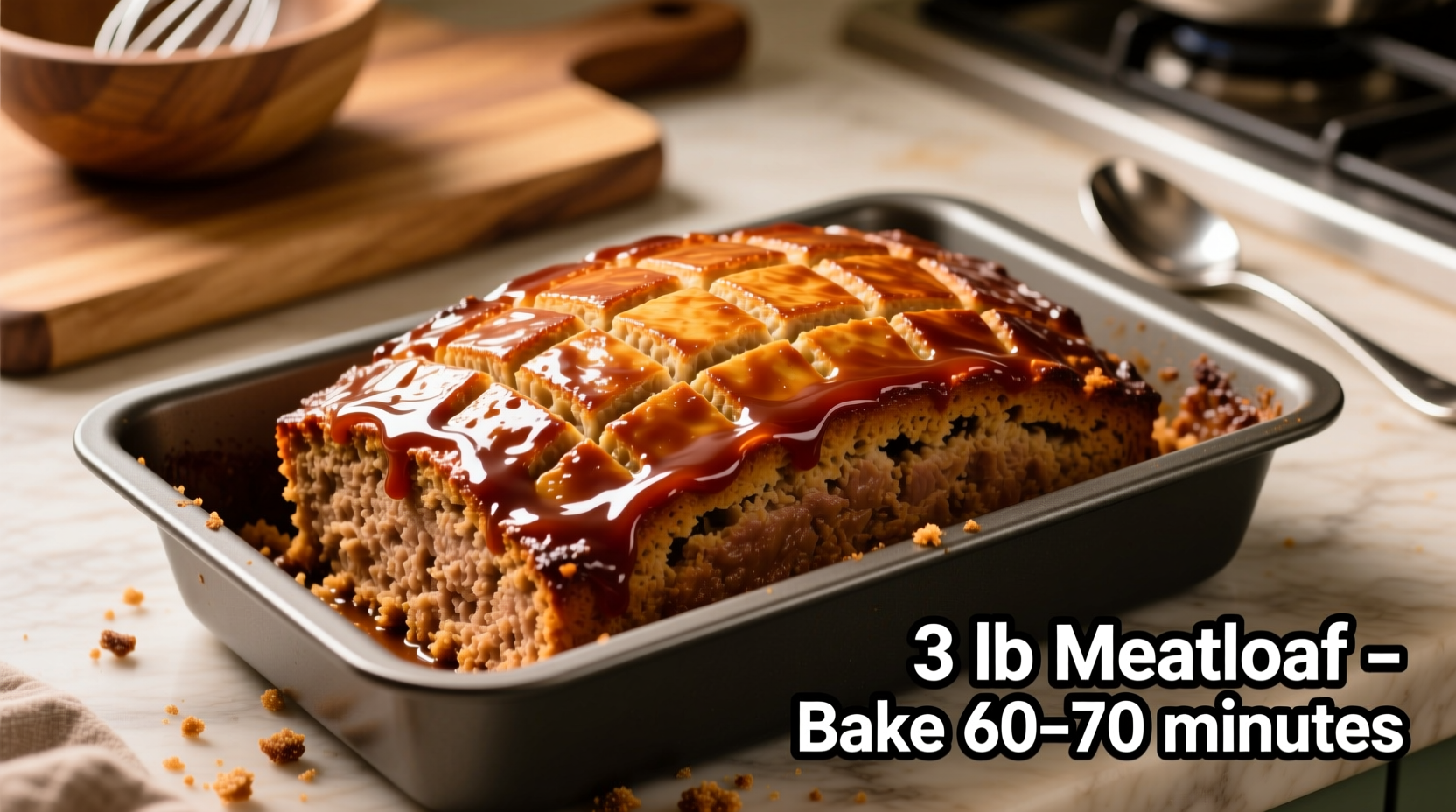For a 3 lb meatloaf, bake at 350°F for 67-75 minutes until it reaches a safe internal temperature of 160°F. Always verify doneness with a meat thermometer, as oven variations and recipe differences significantly impact actual cooking time.
Getting your meatloaf perfectly cooked isn't just about following a timer—it's about understanding the science behind ground meat cooking and recognizing the critical indicators of doneness. As a home cook, you've probably experienced the disappointment of a dry, overcooked meatloaf or the food safety risks of an undercooked center. This guide delivers precise, tested information so you can consistently achieve moist, flavorful meatloaf that's safe to eat.
Why Cooking Time Varies for a 3 lb Meatloaf
The "67-75 minutes" guideline serves as your starting point, but several factors influence the actual cooking time required for your specific meatloaf:
| Factor | Impact on Cooking Time | Recommendation |
|---|---|---|
| Oven temperature accuracy | ±25°F variation can change cooking time by 15-20 minutes | Use an independent oven thermometer |
| Meat fat content | Leaner blends (90/10) cook faster than 80/20 | Check 5-10 minutes earlier with lean blends |
| Pan material | Glass/ceramic adds 5-10 minutes vs. metal | Adjust time accordingly |
| Starting temperature | Cold ingredients add 8-12 minutes | Let mixture rest at room temp for 15 minutes before baking |
According to the USDA Food Safety and Inspection Service, ground meats must reach 160°F internally to eliminate harmful bacteria like E. coli and Salmonella. This safety standard hasn't changed in over a decade, but modern oven technology and recipe variations mean time-based guidelines alone are insufficient.
The Step-by-Step Cooking Process
Follow this verified method for perfect 3 lb meatloaf every time:
Preparation Essentials
Mix your ingredients gently—overworking the meat creates a dense texture. Use a combination of meats if possible (beef+pork+veal) for better flavor complexity. Include moisture-retaining ingredients like grated vegetables or soaked breadcrumbs.
Oven Setup and Placement
Preheat your oven to 350°F with the rack in the center position. Place your meatloaf in a standard loaf pan or shaped free-form on a baking sheet lined with parchment. Free-form shapes typically cook 8-12 minutes faster than loaf pan versions.

Timing and Monitoring
Set your timer for 60 minutes, then begin checking the internal temperature. Insert your meat thermometer into the center of the loaf:
- At 140°F: Continue cooking (approximately 15-20 minutes remaining)
- At 150°F: Check every 5 minutes (approximately 8-12 minutes remaining)
- At 160°F: Remove from oven immediately
Remember that meatloaf continues cooking from residual heat during resting—this carryover cooking typically raises the temperature 5-10°F.
Critical Doneness Indicators Beyond Time
Time alone shouldn't determine when your meatloaf is done. These visual and physical cues confirm proper doneness:
- Juices run clear (not pink) when pierced with a fork
- Surface appears firm with slightly pulled-away edges
- Internal texture is springy but not soft when gently pressed
- Meat thermometer consistently reads 160°F in multiple spots
The American Institute of Baking confirms that visual cues alone are unreliable for ground meat products—only a thermometer provides definitive safety verification. This is particularly important for meatloaf, which has a dense structure that can appear done externally while remaining undercooked internally.
Troubleshooting Common Meatloaf Problems
Dry or Crumbly Meatloaf
Cause: Overcooking by 10+ minutes or insufficient moisture ingredients
Solution: Reduce cooking time by 5-8 minutes next time and add 1/4 cup milk or broth to your mixture
Raw Center Despite Timing
Cause: Oven running cooler than indicated or dense meat mixture
Solution: Verify oven temperature with separate thermometer and ensure even mixing of ingredients
Meatloaf Falling Apart
Cause: Insufficient binders or overmixing
Solution: Use 1/2 cup breadcrumbs per pound of meat and mix just until combined
Pro Tips for Perfect Meatloaf Every Time
Glaze application: Add ketchup-based glazes during the last 15-20 minutes to prevent burning. For sweeter glazes, wait until the last 10 minutes.
Resting is non-negotiable: Allow your meatloaf to rest for 10-15 minutes after baking. This lets the proteins relax and juices redistribute, preventing a crumbly texture when slicing.
Temperature verification: Check multiple spots in your meatloaf, especially if you've added vegetables or other ingredients that might create temperature variations.
When Standard Guidelines Don't Apply
These cooking parameters assume standard meatloaf composition (70-80% meat, 20-30% binders/fillers). If your recipe includes significant modifications, adjust accordingly:
- High-vegetable content (zucchini, mushrooms): Add 5-10 minutes
- Lean meat blends (93/7 or higher): Reduce time by 8-12 minutes
- Convection ovens: Reduce time by 25% or lower temperature by 25°F
- Meatloaf muffins (individual portions): Cook 20-25 minutes











 浙公网安备
33010002000092号
浙公网安备
33010002000092号 浙B2-20120091-4
浙B2-20120091-4